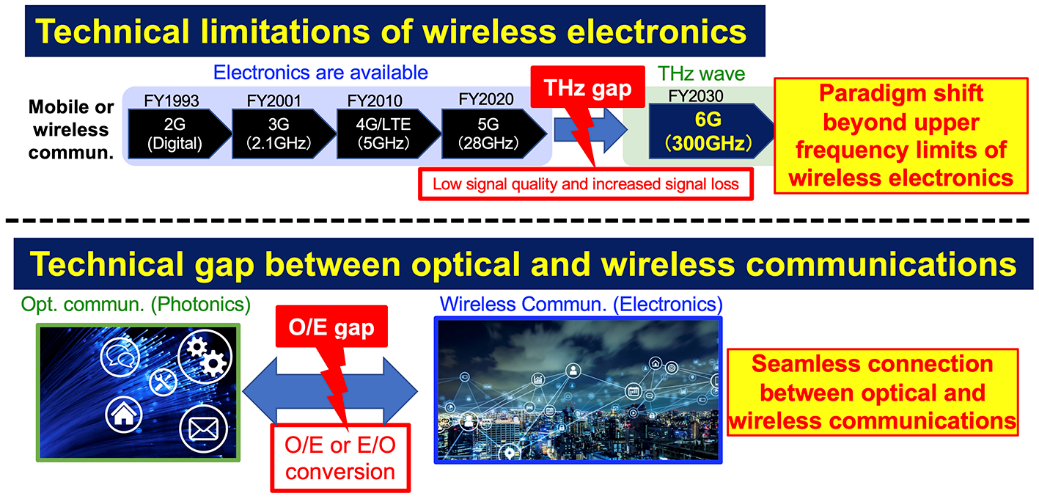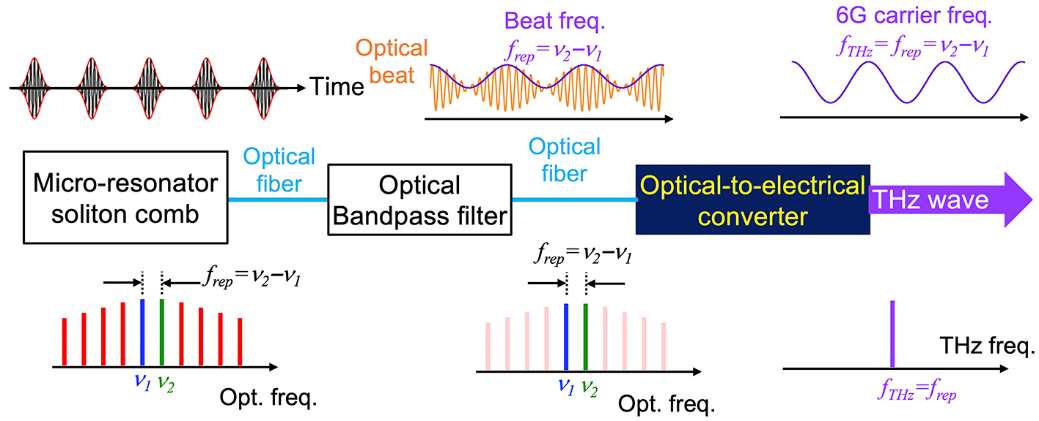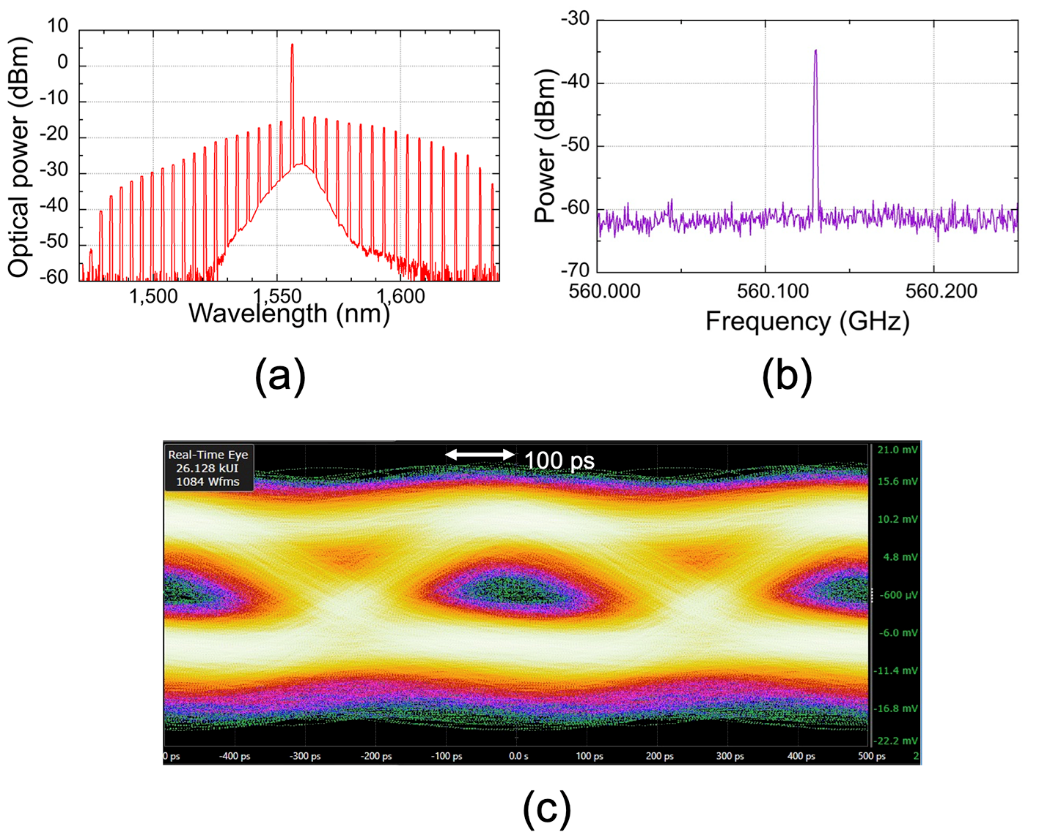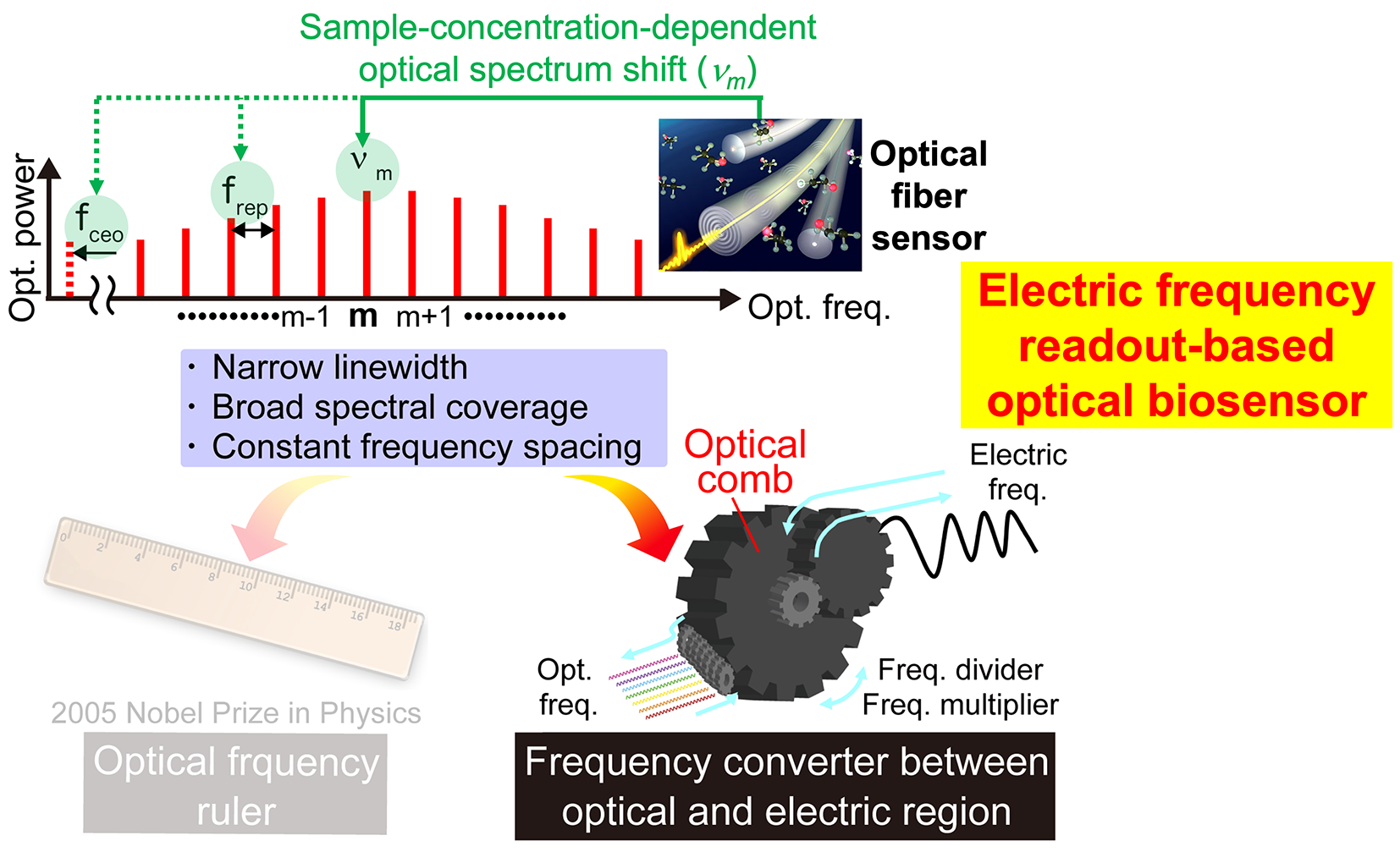- Press Release
【Press Release】Successful terahertz wireless communication using a micro-resonator soliton comb: Expectations for next-generation mobile communications based on photonic technology
Key points
- Wireless electronics that have been used thus far in next-generation mobile communications using terahertz waves may reach their technical limit (namely, upper limit of frequency for wireless electronics).
- Terahertz wireless communication in the 560-GHz band was achieved by optical-to-electrical conversion of ultra-high-frequency photonic RF signals in near-infrared micro-resonator soliton comb.
- Adding the low-phase noise that is characteristic of micro-resonator soliton comb to terahertz waves makes it possible to achieve ultra-high-speed and large-capacity wireless communication using advanced modulation and demodulation of amplitude and phase.
Summary
The research group comprising Associate Profs. Yu Tokizane, Naoya Kuse, Hiroki Kishikawa, and Prof. Takeshi Yasui of Institute of Post-LED Photonics, Tokushima University; former Assistant Prof. Yasuhiro Okamura of the Graduate School of Technology, Industrial and Social Sciences, Tokushima University; Prof. Shintaro Hisatake of the School of Engineering, Gifu University; and Prof. Atsushi Kanno of the National Institute of Information and Communications Technology (NICT) and the Department of Engineering, Nagoya Institute of Technology generated terahertz waves using a micro-resonator soliton comb(Note 2) and applied them to wireless communication at 560-GHz band to solve the described problems. The focus of this study was on the feature that optical frequency spacing of the micro-resonator soliton comb was equivalent to the 6G carrier frequency, and this was used as an ultra-high-frequency photonic RF signal in optical-to-electrical conversion to generate terahertz waves as part of a wireless communication system. This method is expected to not only overcome the technical limit of wireless electronics but also achieve 6G with ultra-high speed and large capacity through advanced modulation and demodulation of amplitude and phase, and which has high affinity with optical communication.
Instruction Video on YouTube by Prof. Yasui Lab. (Tokushima University)
https://youtu.be/4pecF_F0ODY
Research background and history
In mobile wireless communications thus far (2G/3G/4G/5G), technical innovations of higher frequency in wireless electronics have driven technical evolution of each generation in mobile wireless communication. However, the wireless frequency band handled by 6G (terahertz band, frequency of 300 GHz or higher) may reach the technical limit of the wireless electronics (namely, upper limit of frequency for wireless electronics), and there are actual fundamental problems that are beginning to emerge, such as low output and quality of ultra-high-frequency carrier wave and increased signal transmission loss (Fig. 1, upper row). There is a strong need for a paradigm shift that goes beyond the upper limit of frequency in wireless electronics to overcome this status quo. Meanwhile, 6G has the potential to significantly ease the transmission speed gap between optical and wireless communications, but there is a technical gap between the two owing to the differences between optical and electrical technologies, and a time delay occurs owing to the conversion of optical and electrical signals (Fig. 1, lower row). There is a strong need for seamless connections between optical and wireless communication to ensure convenience while utilizing the ultra-high speed of 6G.
Because these two technical issues are due to the use of electronics in wireless communication, they will essentially be solved with the realization of 6G that uses photonics instead of electronics. Based on this idea, we are conducting a research on all-photonic terahertz wireless communication (namely, Photonic 6G(Note 3)), with a micro-resonator soliton comb as the core technology.

Research content and results
In this study, terahertz waves were generated using a near-infrared micro-resonator soliton comb as ultra-high-frequency photonic RF signals whose frequency are equal to 6G carrier frequencies (Fig. 2). When two adjacent modes are extracted by an optical filter from a micro-resonator soliton comb in which multiple optical frequency mode are arranged at regular spacings (= frep), then an optical beat signal is generated in the time domain, and this beat frequency exactly matches the mode spacing of frep. When this optical beat signal is incident on an optical-to-electric converter such as uni-traveling-carrier photodiode (UTC-PD), then terahertz waves with frequency exactly equal to the beat frequency can be generated. The mode spacing of frep is extremely stable in terms of its frequency and phase, and the UTC-PD conducts optical-to-electrical conversion without impairing the high stability of frequency and phase in the frep, thereby yielding extremely high-quality terahertz waves. Here, if transmission information is superimposed on one of the extracted adjacent dual-mode light by an optical modulator, then the generated terahertz wave will be modulated. In this study, a wireless communication experiment was conducted using on-off-keying (OOK) amplitude-modulated terahertz waves (frequency 560 GHz) at 2 Gbps.

Figure 3(a) shows the optical spectrum of the ultra-high-frequency photonic RF signal that is generated using the micro-resonator soliton comb, indicating that multiple modes are lined up with a mode spacing of 560 GHz. Here, the frequency spacings of the individual modes of the micro-resonator soliton comb are constant, and the phases are completely synchronized with each other. Fig. 3(b) shows the spectrum of the generated terahertz wave, whose frequency exactly matches the mode spacing of the micro-resonator soliton comb. Next, data transmission experiments were conducted by propagating OOK amplitude-modulated terahertz waves in space and receiving them with a terahertz detector. Fig. 3(c) shows the time waveform of the received signal (namely, eye pattern), and an eye-shaped space could be observed in the central part of the time waveform signal, confirming that the data transmission experiment was successful.

Division of roles
- Tokushima University: Device basic design, system construction, demonstration experiment
- Gifu University: Terahertz design, experimental assistance
- National Institute of Information and Communications Technology and Nagoya Institute of Technology: Conceptual design, experimental assistance
Future developments
In this study, terahertz waves were generated using a free-running micro-resonator soliton comb. Because the most important feature of this method is the low phase noise, the aim in the future is to generate terahertz waves with ultra-low phase noise using a stabilized micro-resonator soliton comb, and to utilize this superior characteristic to achieve terahertz communication (e.g., quadrature amplitude modulation or QAM that combines phase modulation and amplitude modulation).
Terminology
(Note 1) Next-generation mobile communication (6G)
Next-generation mobile communications (6th-generation mobile communications) that are scheduled to start service in 2023 will use terahertz waves of 300 GHz or higher as wireless carriers. The communication methods require conditions such as “Extreme high data rate/capacity,” “Extreme low latency,” “Extreme coverage,” “Extreme high reliability,” “Extreme low energy and cost,” and “Extremely massive connectivity and sensing.”
(Note 2) Micro-resonator soliton comb
A micro-resonator soliton comb has an ultra-discrete multispectral structure in which multiple optical frequency modes are arranged at regular spacings similar to a hair comb, and it is possible to generate ultra-high-frequency photonic RF signals that are of immensely higher quality than those generated by electrical methods. Furthermore, because semiconductor processes can be used for mass-production, micro-resonator soliton combs can be expected to be ultra-compact, simple, and low-priced in the future.
(Note 3) Photonic 6G
“Photonic 6G” is a registered trademark of Tokushima University (Registration No. 6537005).
Acknowledgments
We acknowledge the financial support for the project from the Promotion of Regional Industries and Universities by the Cabinet Office, as well as from the Plan for Industry Promotion and Young People’s Job Creation by the Creation and Application of Next-Generation Photonics by Tokushima Prefecture. This research has been partly conducted under the contract “R&D of high-speed THz communication based on radio and optical direct conversion” (JPJ000254), and the project for strategic intellectual property, standardization, and business promotion to accelerate the transition to the Beyond 5G era made with the Ministry of Internal Affairs and Communications of Japan.
Reference
| Journal | Optics Continuum |
| Title of original paper | Terahertz wireless communication in a 560-GHz band using a Kerr micro-resonator soliton comb |
| Authors | Yu Tokizane, Shota Okada, Kenji Nishimoto, Yasuhiro Okamura, Hiroki Kishikawa, Takeo Minamikawa, Eiji Hase, Jun-Ichi Fujikata, Masanobu Haraguchi, Atsushi Kanno, Shintaro Hisatake, Naoya Kuse, and Takeshi Yasui |
| DOI | 10.1364/OPTCON.491729 |
Related patents
We have filed three related Japanese patent applications.



